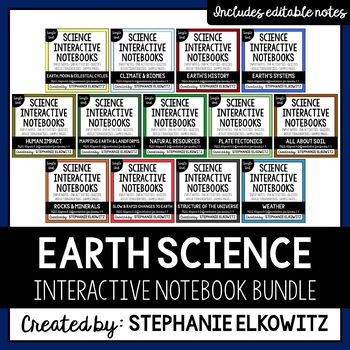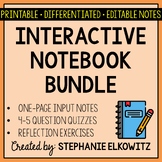Earth Science Interactive Notebook Bundle | Editable Notes
- Zip
What educators are saying
Products in this Bundle (13)
showing 1-5 of 13 products
Also included in
- SAVE 40% by purchasing ALL my PRINTABLE Interactive Notebook Units! EDITABLE Input Notes Included!About this ProductThis differentiated unit bundle includes 47 INB units. Each unit is composed of INB lessons organized into chapters. Each chapter includes:• An overview with photos of the completed INPrice $344.40Original Price $574.00Save $229.60
Description
SAVE 30% by purchasing ALL my Earth Science Interactive Notebook Units! EDITABLE Input Notes Included!
About this Product
This differentiated unit bundle includes 13 INB units. Each unit is composed of INB lessons organized into chapters. Each chapter includes:
• An overview with photos of the completed INB activity
• One page of input notes (differentiated when necessary)
• At least one INB activity (key included)
• A 4-5 question mini assessment (key included)
• A 2-part reflection exercise
Important Notes:
• Download a FREE Interactive Notebook Unit to learn more about my INB units
• Save $$$ with the Earth Science Complete Curriculum
• Save $$$$ with the Integrated Science Complete Curriculum
*********************************************************************************************************
EDITABLE INPUT NOTES
• 100% one-page EDITABLE copies of input notes are included
• Notes are saved as a single .docx file that opens with Microsoft Word & Google Docs
• Editable notes are written in font compatible with Microsoft Word & Google Docs
*********************************************************************************************************
This bundle includes the following INB Units:
• Climate and Biomes Interactive Notebook Unit
Chapter 1: What is climate?
Chapter 2: Factors that Affect Climate
Chapter 3: Climate vs. Weather
Chapter 4: Climate and Latitude
Chapter 5: Biomes
Chapter 6: Graphing & Mapping Biomes
Chapter 7: Wind Currents & Climate
Chapter 8: Ocean Currents & Climate
Chapter 9: Using Fossils to Study Climate
Chapter 10: History of Earth's Climate (Glacial and Interglacial Periods)
• Earth, Moon and Celestial Cycles Interactive Notebook Unit
Chapter 1: Gravity
Chapter 2: Rotation vs. Revolution
Chapter 3: Time Units
Chapter 4: Celestial Cycles
Chapter 5: Sun’s Movement & Shadows
Chapter 6: Stars Movement at Night
Chapter 7: Seasons
Chapter 8: Seasonal Constellations
Chapter 9: Earth’s Revolution & Seasons
Chapter 10: Earth’s Tilt
Chapter 11: Sun’s Altitude & the Seasons
Chapter 12: Lunar Phases
Chapter 13: Eclipses
Chapter 14: Tidal Cycle
Chapter 15: Spring vs. Neap Tide
• Earth's History Interactive Notebook Unit
Chapter 1: Geologic Time Scale
Chapter 2: Early Earth (Precambrian)
Chapter 3: History of Life on Earth
Chapter 4: Mass Extinctions
Chapter 5: Fossils (How they form, how we study them)
Chapter 6: Types of Fossils
Chapter 7: Index Fossils
Chapter 8: Relative Dating
Chapter 9: Absolute Dating (Carbon Dating)
Chapter 10: Studying Past Climate with Tree Rings
Chapter 11: Studying Past Climate with Ice Cores
• Earth's Systems: Geosphere, Atmosphere & Hydrosphere Interactive Notebook Unit
Chapter 1: Earth’s Spheres (Hydrosphere, Geosphere, Atmosphere, Biosphere)
Chapter 2: Abundance of Elements (in the Crust, Hydrosphere and Troposphere)
Chapter 3: Inside Earth
Chapter 4: Continental vs. Oceanic Crust
Chapter 5: Water on Earth
Chapter 6: Freshwater vs. Saltwater
Chapter 7: Water Cycle
Chapter 8: Water Cycle around Earth
Chapter 9: Layers of the Atmosphere
Chapter 10: Atmospheric Gases
Chapter 11: Atmospheric Pressure & Temperature
Chapter 12: Types of Clouds
Chapter 13: Wind Patterns
Chapter 14: Ocean Currents
• Human Impact Interactive Notebook Unit
Chapter 1: Earth’s Resources
Chapter 2: Human Impact on the Environment
Chapter 3: Negative Environmental Impact
Chapter 4: Pollution
Chapter 5: Air Pollution
Chapter 6: Water Pollution
Chapter 7: Acid Rain
Chapter 8: Land Pollution
Chapter 9: Ozone Depletion
Chapter 10: Global Warming
Chapter 11: Evidence for Climate Change
Chapter 12: Human Population Growth
Chapter 13: Human Impact on Other Species
Chapter 14: Biological Magnification
Chapter 15: Conservation & Sustainability
Chapter 16: Solving Environmental Problems
• Mapping Earth and Landforms Interactive Notebook Unit
Chapter 1: Mapping Earth
Chapter 2: Finding Latitude with Polaris
Chapter 3: Reading Topographic Maps
Chapter 4: Creating Topographic Maps
Chapter 5: Creating Topographic Profiles
Chapter 6: Landforms & Bodies of Water
Chapter 7: Coastal Landforms
• Natural Resources Interactive Notebook Unit
Chapter 1: Natural vs. Synthetic Resources
Chapter 2: Renewable vs. Nonrenewable Resources
Chapter 3: Synthetic Products
Chapter 4: Distribution of Natural Resources
Chapter 5: Effects of Uneven Distribution
• Slow and Rapid Changes to Earth Interactive Notebook Unit
Chapter 1: What is weathering?
Chapter 2: What is erosion?
Chapter 3: Gravity’s Role in Erosion
Chapter 4: Rate of Erosion
Chapter 5: Waterfall Formation
Chapter 6: Deposition
Chapter 7: Slow Change Summary
Chapter 8: River Erosion & Deposition
Chapter 9: Evidence for Slow Change
Chapter 10: Landforms & Slow Change
Chapter 11: Cave Formation
Chapter 12: Rapid Changes to Earth
• Soil Interactive Notebook Unit
Chapter 1: What is a soil?
Chapter 2: How does soil form?
Chapter 3: Soil Textures
Chapter 4: Types of Soil
Chapter 5: Layers of Soil
Chapter 6: Living & Nonliving Parts of Soil
• Rocks and Minerals Interactive Notebook Unit
Chapter 1: What is a mineral?
Chapter 2: How do minerals form?
Chapter 3: Mineral Properties (Includes Mohs' Hardness INB activity)
Chapter 4: Common Minerals
Chapter 5: Mineral vs. Rock
Chapter 6: Types of Rocks
Chapter 7: Sedimentary Rock Formation
Chapter 8: Rock Cycle
• Structure of the Universe Interactive Notebook Unit
Chapter 1: Structure of the Universe
Chapter 2: History of the Universe (The Big Bang Theory)
Chapter 3: Composition of the Universe
Chapter 4: Types of Galaxies
Chapter 5: Celestial Objects
Chapter 6: History of Our Solar System
Chapter 7: Our Solar System
Chapter 8: Solar System Trends
Chapter 9: Stars
Chapter 10: Life of a Star
Chapter 11: Extraterrestrial Objects (Asteroids, Comets, Meteoroids)
• Tectonic Plates Interactive Notebook Unit
Chapter 1: Plate Tectonics
Chapter 2: Types of Plate Boundaries
Chapter 3: Plate Boundary Landforms
Chapter 4: Seafloor Spreading
Chapter 5: Convection in the Mantle
Chapter 6: Continental Drift Theory
Chapter 7: Evidence for Pangaea
Chapter 8: Volcanoes
Chapter 9: Volcanic Island Formation
Chapter 10: Earthquakes
Chapter 11: Types of Faults
Chapter 12: Earthquake & Volcano Mapping
Chapter 13: Seismology
• Weather Interactive Notebook Unit
Chapter 1: What is weather?
Chapter 2: Describing Weather
Chapter 3: Weather Station Model
Chapter 4: Sun’s Role in Weather
Chapter 5: High vs. Low Pressure
Chapter 6: Types of Air Masses
Chapter 7: Weather Fronts
Chapter 8: Types of Clouds
Chapter 9: Weather Patterns in the US
Chapter 10: Isotherm Maps
Chapter 11: Reading Isotherm & Isobar Maps
Chapter 12: Hazardous Weather
Chapter 13: Weather Safety
Chapter 14: Reducing Weather Impact
Chapter 15: Rain Shadow
Chapter 16: Land vs. Sea Breeze
Chapter 17: El Nino and La Nina
Chapter 18: Hurricane Formation
Additional Information
- Topics are differentiated for upper elementary and intermediate grades.
- Topics are differentiated with a color and shape code.
- Two pages of generic and self-assessment reflection prompts are included.
NGSS Alignment
Download the preview for a reference file to help you align your INB lessons to the Next Generation Science Standards and Disciplinary Core Ideas. The content in these products exceeds NGSS in order to satisfy state standards, to provide background information to NGSS and to enrich or enhance NGSS.
TERMS OF USE
• All rights reserved by Stephanie Elkowitz.
• This product is to be used by the original purchaser only.
• Intended for classroom and personal use only.
• Copying for more than one teacher, classroom, department, school, or school system is prohibited.
• This product may not be distributed or displayed digitally for public view.
• Failure to comply is a copyright infringement and a violation of the Digital Millennium Copyright Act (DMCA).



